-
Posts
1,369 -
Joined
-
Last visited
Content Type
Profiles
Forums
Gallery
Events
Posts posted by hollowneck
-
-
Finished the fabrication of Camilla's last two sails today, the large main and fore courses. These were easily the most difficult to make which is why I guess I left them to last...😬
Like her other sails in these photos, all eleven of her working sails are temporarily mounted to determine if all is ready for the next stages of prepping their rigging.
However, before I mounted Camilla's last two sails I noticed that several of my rigging blocks (on the spritsail and mizzen topgallant braces - to name two) like to spring into a twist, which is a no-no. This is always an issue with single blocks and neither a unique nor new problem. I believe the tension of the rope strands that lash the block exerts sufficient enough rotation to twist a rigging line - like this:
There must be some easy solution to address this annoying fact. I had an idea. Here's what appears to be a very simple fix to this issue, as follows:
I coated the standing tarred line to the single blocks with Liquitex Matte Medium as an adhesive with only a tiny amount applied along the rope from its anchor point to its stropped block. The tarred line appears shiny here because the medium has been recently applied (toothpick as applicator). The small alligator is sufficient to hold the lines (and block) straight, untwisted while coating the rope; the clip holding the block is necessary before applying the matte medium. The adhesive will be nearly invisible when dry and will hold the block and lines in-place. The adhesive on the line nullifies the torsional rotation.
Twisting issue solved. I think. I'll see if my fix holds true in the coming days. In the meantime...
I shot this photo to check that my sizing for the main course was adequate.
Another overall photo with all sails now temporarily mounted. After I assess whether or not any last-minute sail fabrication adjustments or changes will be necessary, I'll proceed with each sail's additional rigging details. In this photo one can clearly see the "twist" to the lines for the mizzen topsail's braces. In fact, this pic caused me to figure something out to address this pesky problem. This said, note that this isn't a problem with the main course's bracing lines to the stern sheaves. I speculate that the thinner the rope and the more taut one rigs their lines, the more likely you'll run into the "twisties."
Cpt. Pennypincher has ordered that the stern ensign staff be removed since it will foul the mizzen course as it currently stands. Camilla's getting in good order, quite ship-shape, and with some good weather and a little Irish Luck, she'll be ready to leave her mooring within a fortnight...(or two)
- bobandlucy, whitejamest, Blue Ensign and 11 others
-
 8
8
-
 6
6
-
5 hours ago, druxey said:
If using that image, allow for the yellowed varnish having altered the actual coloration of the painting. It is likely much bluer under
Thank you, druxey for the information and the link.
Elliot was somewhat unique in that he was also a Royal Navy Lieutenant in addition to being an artist/painter/engraver.
Viewing a couple of his other paintings revealed to me that he had a very stylized approach to rendering his seas; "choppy" green-tinged water in several of his works.
His paintings are heavily varnished (evident in auction photos) and one doesn't need specialized optics to assess this. Several layers of varnish has indeed shifted the color hues beneath the layers, particularly after a century or two of aging! Old varnish (and often shellac) is very yellow-hued, sort of like one's vision before cataract surgery, wherein everything is tinted with an organic yellow filter.
I'm visualizing grey/blu water with a touch of green. Thankfully, my vision is post-cataract correction!
-
6 hours ago, Blue Ensign said:
In a seascape setting under sail I think the Ensign would be worn at the Gaff from the Ensign halyard, rather than the staff which would normally be employed with the ship at anchor.
Yes, this is how I've normally handled this and I was planning to do similarly with this model. This is the first model I've built with the stern ensign staff, so I was a little confused what to do: leave it or take it down? I'll likely remove it, not needed. Your explanation makes perfect sense: it's quite likely it wasn't mounted when underway. Thanks!
-
7 hours ago, BobG said:
This is one of the most interesting build logs I've ever read, Ron. I can't wait to watch you make the diorama. I say go for the dramatic and put her in stormy seas!
Thanks, BobG. When I decided to do a Build Log (my first), I knew I'd need to do many photos and detailed procedural descriptions. I'm pleased that you have found my work interesting. At this moment I AM thinking a choppy sea, some swells, Camilla heeling with filled sails. Stay tuned!
-
As I hunker down on the remainder of my sailmaking and rigging (more details to come and be explained), I've been researching water right along for HMS Camilla's diorama.
Of dozens I've stashed on my computer, here's four very specific paintings I've been looking at for inspiration. My diorama setting is the English Channel. On very few occasions have I ever seen "blue water" in the Channel. Of course, there are sunny days with gloriously bluegreen aqua, however, I've rarely see them - especially when the sky is foreboding and squalls are rolling across the choppy water...enjoy.
All of these are beautiful, stunning depictions.
Making water and designing the presentation platform/case lies right around the bend - (ing - as in mounting all her sails)...
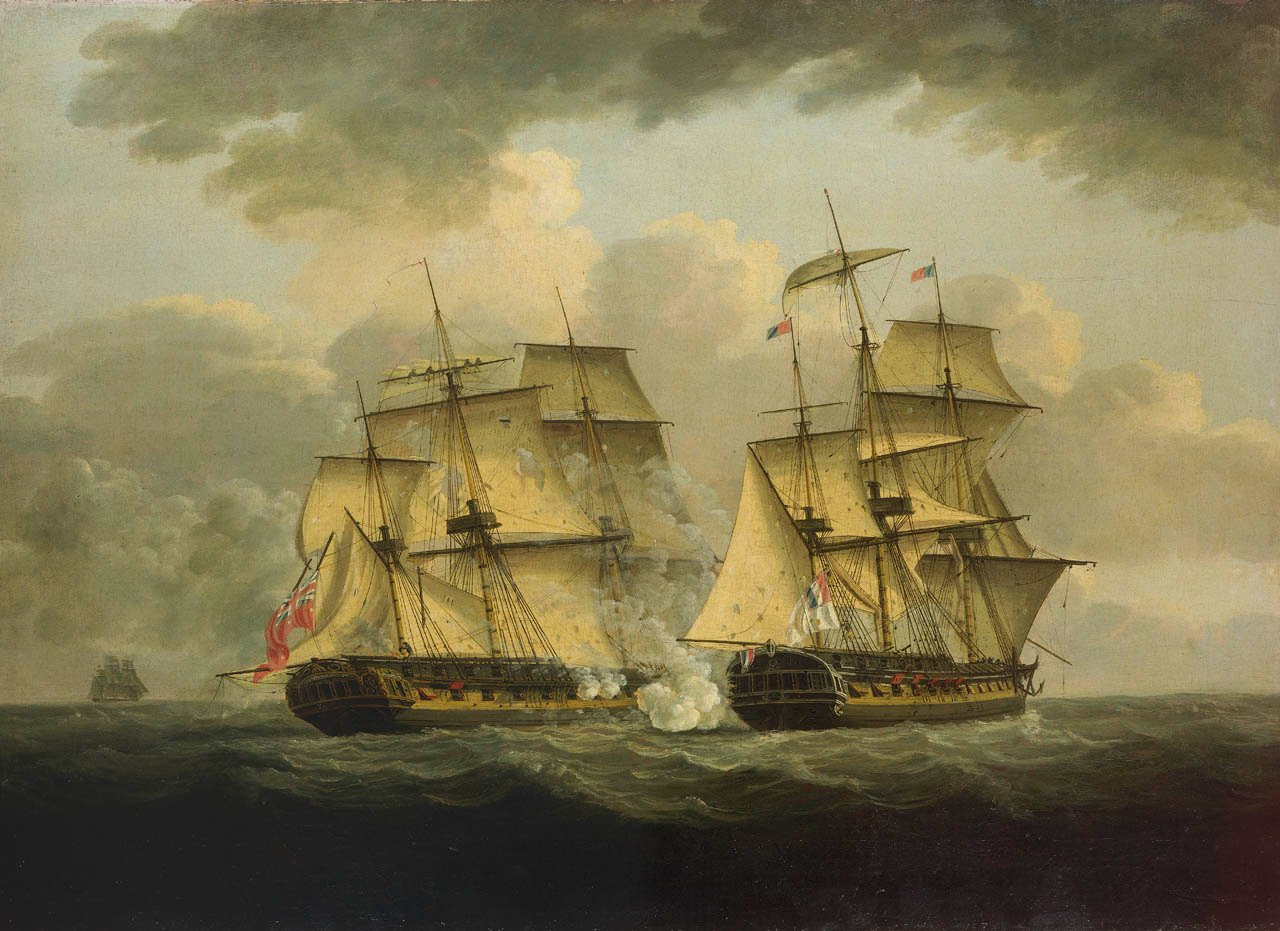
Probably one of the best candidates for my model's sea coloration. English Artist: Elliot (unsure of the date/era)
HMSCUmberlandfightingagainsttheLeLysandLaGloire1827.thumb.jpg.ffca383b502fdc72360f3ffb01e52d2d.jpg.ff4354c4ed1b04e05abaddf58df8d27f.jpg)
Perhaps the next best reference choice for water coloration. Although quite exaggerated, I like the choppiness of the wave action. But Love the French officer jumping from the stern, English lobsters in pursuit. French Artist (19th-C): Crepin
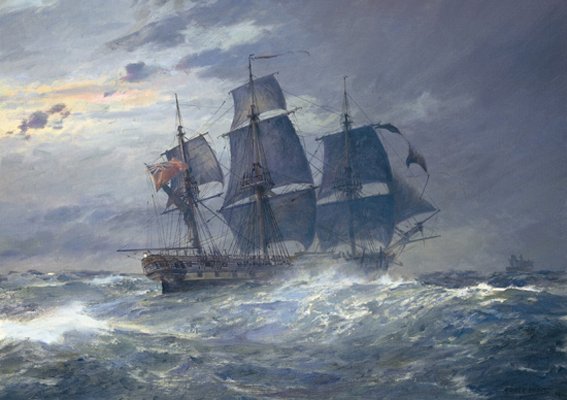
Then, for wave action (and sky!), I'm really relishing a possible attempt to depict this sort of stormy, squally sea. This is the HMS Indefatigable by contemporary English painter, Geoff Hunt. As many here know, this is the subject ship for Chris Watton's (Vanguard) next kit.
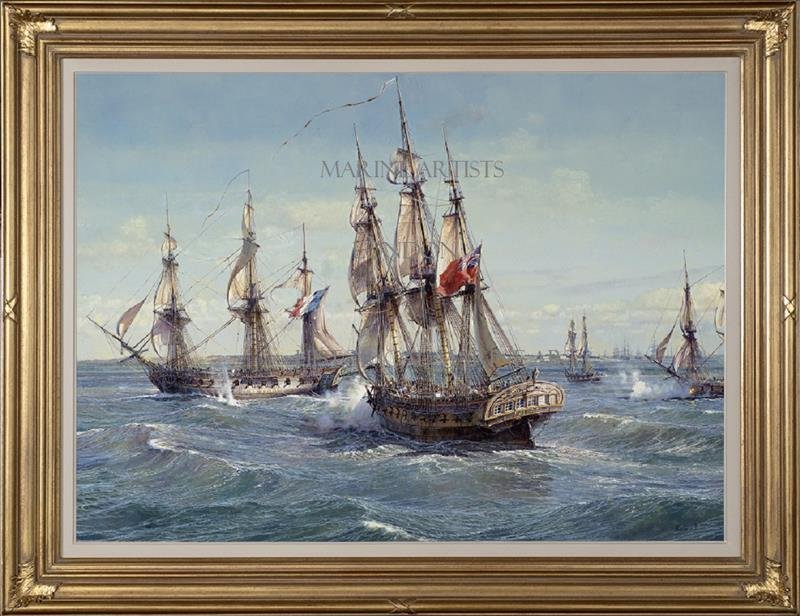
Or, the greyish/green rollers in the Channel. By Dutch contemporary painter: Platje
I have a dedicated "Skies/Weather" folder for photo/painting reference too. I'll share these when I start making water in earnest; my plan is to also show "sky" in Camilla's presentation. More on this later if I can figure-out some mechanics that aren' too awkward.
Cheerio.
Now back to those (pressing) sails...
-
Very nice,B.E. Clever to use a couple of Chris’ scale figures to get the correct height at the stern. I love that your work surface resembles mine. I sneezed at my bench today and several tiny rigging hooks instantly disappeared into the morass of bits n’ pieces, tools, etc…it’s good that there are plenty more on the P/E frets!
- mtaylor, Blue Ensign and Dave_E
-
 3
3
-
17 minutes ago, Rustyj said:
Excellent workmanship and description Glenn. A perfect example of planning and patience!
I agree with Rusty. Very pristine, precise work. When completed, your Winchelsea scratch is going to be a stunning model.
- Dave_E, Blue Ensign, FrankWouts and 1 other
-
 4
4
-
Steady as she goes...
Nine of Camilla's eleven sails are temporarily hung from their yards. After fabricating her final two courses (Main & Fore, the largest and last of her sails), I'll mount boltropes, reef points as well as rig and prep all the clews. After clews, the braces will be adjusted and/or added.
As can be seen here, the mizzen's gaff needs to be lowered a tad; luckily I've left enough rigging rope to do this without shorting the falls! The mizzen course is lashed to the mizzen mast and tied to the gaff spar and is loose-footed. This is a very tricky area to model since there is a large flag of the King's colors that gets rigged to the ensign staff just behind the large fore-aft sail. I may need to rig the flag higher-up to the gaff's end with an appropriate halliard line.
Bending the sails at this stage requires some delicate work, but this is how I've mounted sails previously and it works for me. This also my first model to mount and rig a spritsail topsail. More bowlines and bunts to figure out where to belay them! Meanwhile...
...Cpt. Pennypincher is hiding behind the mizzen course, keeping a sharp weather eye out for mischief by the riggers...
The beginning layout for Camilla's main course (on my sail's bond paper); these last two sails take up nearly the entire width of my new light table to draft. At the top of the photo, my reference for detailing this sail and the fore course will be taken from David Antscherl's Swan Series Vol IV on rigging. Camilla is not a sixth-rate, however her rigging and sail complement is very similar. The width (call it breadth) of this main course measures approximately 14 1/2" to the very ends of the stunsail booms. In earlier months I seriously considered mounting stunsails when getting to these final stages of my build.
Now , it's Plan B...
No stunsails - as much as I'd like to make these and show Camilla with even more sail in her diorama. Adding stunsails - even on only one spar - would increase her total breadth by more than a foot! This would make her nearly 28-30" across her beam, nearly as wide as she is long. If I hold to this initial plan I've only recently realized this would require her diorama to be quite large since a large ship model must have a decent amount of "water" surrounding the portrayal. Why bother with a diorama presentation approach otherwise?
"Adios, stunsails."
Perhaps some other scale, or model - or life.
-
9 hours ago, Rokket said:
Great sails, thanks for sharing the technique.
Thank you Rokket for looking in and the compliment! It's one of the steps I love about building model ships in this era. Sails breathe "life" (nearly literally) into a static model. The other step, of course, is creating the sea upon which her sails will carry her: the motion and then the motive!
6 hours ago, Gahm said:Excellent sail making technique . . . and very well explained! Thank you for sharing.
Thomas
Thomas - many Thanks. I realize that sometimes my explanations get long-winded, but describing my complex process calls for more words, not fewer! I'm glad you as well as others appreciate the granular detail involved.
I need to mention that every time I get to this stage for my models (this will be the 5th one with sails) I learn something new, sometimes it's subtle improvements to technique, sometimes dramatic. Even a new tool, like my new thin line LED light table, which is a great help in the early sail drafting stages. There is such a deep well of limitless knowledge here. And I thank all of you for inspiration, critique and positive acknowledgement alike.
- chris watton, Gahm, BobG and 1 other
-
 4
4
-
2 hours ago, Ian_Grant said:
Rope truss pendants.......
The illustration showing the truss pendants (from Ian_Grant) is from a very handy book on rigging by Lennarth Peterrson : Rigging Period Ship Models. It covers an earlier era than that of your model but remains a good reference for much of the sail rigging that extended into the early 19th-century. Highly recommended. I use it as a key reference for my 18th-C models. Available and in print, not too expensive. As you can see, he's a detailed draftsman and has done a good job illustrating - with very clear diagrams - the essential square sail rigging details throughout his book.
- Ian_Grant and bobandlucy
-
 2
2
-
On 8/11/2022 at 8:26 AM, Ian_Grant said:
Looking great!
I concur. Nice-looking model.
-
-
3 hours ago, BobG said:
This is an outstanding sail making tutorial. Thanks, Ron!
You are welcome, Bob, much appreciated.
I'm pleased that you are finding some of the details helpful. Should you choose to tackle making your own sails with my process, I believe the results will be quite rewarding.
-
1 hour ago, mtaylor said:
Your sails are looking super, Ron. I like the translucence of them as it gives a more realistic look.
Thanks, Mark.
I agree that part of creating realistic-looking sails is to have some translucency to them. By looking at paintings from the era one can see that actual canvas sails were thin enough to allow light transmission, despite the heaviness of the material.
-
Sail fabrication continues. The details described and shown in this update are essentially the same for all the sails. The most difficult and time-consuming to make are the topsails (Fore, Main & Mizzen). These sails are large, have various linings (added canvas reinforcement pieces), and reef points. The remainder are smaller and with the exception of the lower spritsail and mizzen course (a fore/aft lateen) have no linings or reef points.
After applying silkspan pieces to the reverse side of the sail layouts, they get trimmed to their final sizes with a craft knife. The next step is applying the mast cloth, linings and tablings (leech and foot) shown here. Shown here is the Main Topsail, the largest sail that Camilla will show deployed. The tabbed edges for both leeches and the foot are bent upward to form a "trough" on three sides. These protrusions that were described in the sail layout stage become the tab linings for the simulated boltropes. Because the sail has now become considerably thicker with the silkspan layers, bending the three narrow (4mm) tabs requires a straightedge and a thin lifting tool to create properly. It is important to fold these tabs as accurately and consistently as possible along the sail's three sides. There is no tab at the sail's head as it attaches to the yard directly with roband ropes. I use the reverse edge of an X-acto knife to carefully lift the tabs against a tightly held straightedge to accomplish the upward bending. Careful finger pressure brings the tabs to an upright position so it's easy to apply glue along the fold with a toothpick.
I use Liquitex matte medium adhesive to affix all the sail linings as shown: mast cloth, lower lining and reef bands. A small paintbrush, some toothpicks and a dish of water are necessary for this step. The additional sail pieces are cut from scrap silkspan leftovers and are the same color.
Once the sail has had its linings applied, I use an awl and a small drill to make the reef points and roband holes that will get ropes mounted through them at a later stage. The rope I'll use for both is .03 mm in the normal hemp running rigging color. In the photo is the spool of wire that gets mounted to the sail's leeches and foot. The wire is 32 ga. annealed and coated wire (florist wire); it's pliable and because it's soft steel, the coating keeps it from rusting. This is important as water-based Titebond glue is used to seal the edges as will be demonstrated.
This photo shows the placement of the leech forming wire. The wire will be enclosed within the boltrope "tab.” This forming wire technique will be applied to three sides of the sail.
The thin wire is held captive within the sail's three edges (both leeches and the foot) by the foldover tabs previously shown; these "tabs" also simulate the edge linings of the sail which will later get boltropes affixed. The wire is cut over-length to the sail's edges and later trimmed-off. However, the extra wire at the head of the sail is kept long purposefully; this small length of protruding wire becomes a temporary suspension point that holds the sail onto the yard as it is mounted with its ropes (robands).
A small diameter dowel is a close approximation of the sail's yard thickness and helps to form the protruding suspension wire at both head leeches. The length of the wire isn't critical; just enough so that it can hang on its yard and be mounted with ropes. It can be left in-place or snipped-off after serving its purpose: I snip it off after bending the sail to its yard.
An extreme close-up of one corner intersection of a leech and the sail's foot. Note that the wire-retaining "tabs" are trimmed at sufficient angles to create a tight corner seam- without an awkward overlap. The corners have been carefully "notched" with a knife in the earlier sail cutting out step.
A sail that has all its boltrope tabs formed (leeches and foot). The sail's head suspension wire at the bottom can be seen. The three folded-over tabs have their encapsulated wires glued in-place.
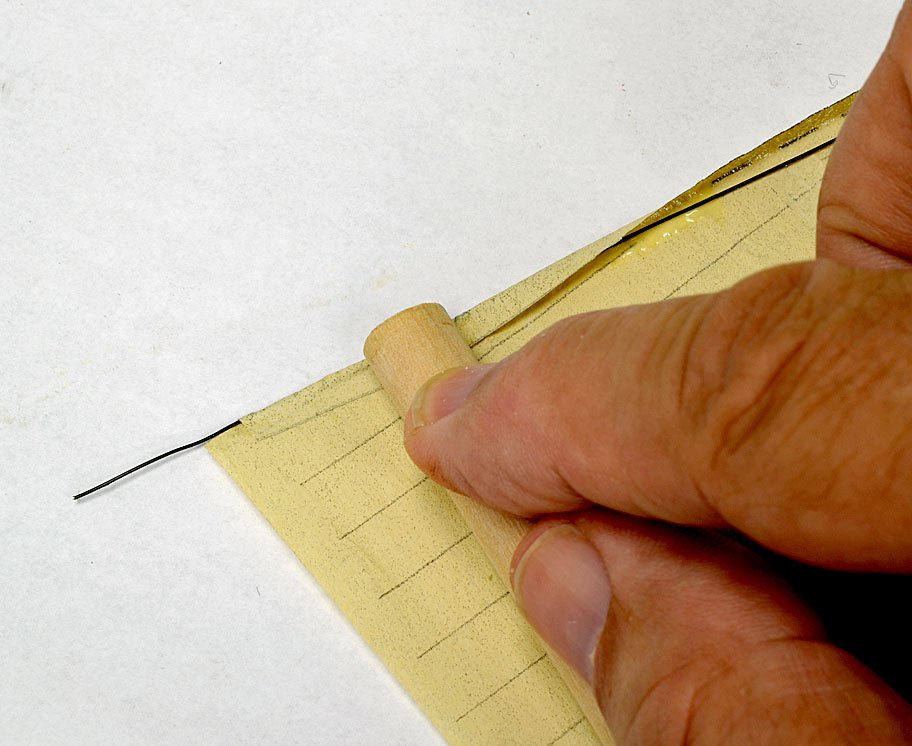
To seal the wire along the edges of the sail a simple dowel can be used once glue has been added along the full length of the tab. It's important to "push" the wire with the dowel's tip so that it sits at the very edge of the trough created by the folded over tab. Some glue will squeeze out when this is properly done (but don't use too much glue!). Since white glue is slow drying this isn't a problem; you'll need to scrape or wipe off any excess that appears. The sail's boltropes will be attached to these three lining tabs later.
For gluing the tabs I use undiluted white aliphatic glue (TiteBond), applied with a toothpick along the full length of the sail. This photo is taken from an article I authored a couple years ago for the NRG Journal on my sailmaking. The colors of the sail material shown don't match the previous due to lighting differences. The yellow-hued glue can be seen in the trough containing the forming wire.
A view of the main topsail formed by carefully bending and shaping the three edges containing the encapsulated wire. Boltropes, reef points (lines) and cringles will be added. I've formed the sail here to show the effect of the involved process of "wiring" the three edges; I'll not finalize the shape of the sails until much later when they're ready to be mounted to their respective yards.
Another view of a "formed" sail. Both photos were taken specifically to show how the wire helps to create a "billowing" effect of the sail. The suspension loops at the sail's head are clearly seen. The protruding wires at the intersection of the leeches and foot will be trimmed off.
The temporary placement of the semi-completed Main Topsail on HMS Camilla.
Another slightly closer view of the sail. It's temporarily suspended by the two small wires at the head on either leech. Note the translucency of the sail materials. The three layers that comprise the sail still permit subtle light transmission. The random, tiny wrinkles in the sail (middle, left) doesn't bother my eye.
A photo of the topsail without the effect of backlighting. The dramatic shadows are a fun visual side-effect!
And a view of the main topsail from Camilla's port bow. Still, a little naked-looking.
The foot hangs below the mainmast top and is restrained by its crowsfeet. When fully-mounted, the foot will drop down another 10-15mm from its current position; a good sign that I've gotten a good handle on my overall sail measurements. There is no sail plan (per se) in the Sphinx kit. However, there are very helpful belaying plans for the basic rigging included.
I have used measurements taken directly from Camilla's yards as well as calculated sail dimensions based roughly on information in Lee's as well as David Antscherl's Swan series, Vol #IV and L. Petterson's books on rigging details. Once clewlines, bowlines and bunt lines are added, the sail will present even more convincing visual movement. Depending on the final placement in her diorama (the effects of wind and water), Camilla's yards may be braced to show correct positions on a tack; I don't yet know exactly what the angle of the yards will be.
Once all the sails are fully fabricated and formed, the robands, reef point ropes, all boltropes and cringles for sail management lines will be added. These final steps will be detailed once all Camilla's sails have been brought to this stage as explained in this update.
There's lots more critical details to come.
-
HMS Camilla is slowly getting her wings. Now that I've created all the paper layouts ( 9 sails) and painted the silkspan, it's time to start some lamination, as follows:
After spraying a fine mist of 3M adhesive to the paper layout, a cut piece of the painted silkspan is applied gingerly to only one side. You want to make sure you handle the paper layout carefully, and minimally. One reason is that the pencil line graphite will easily smear and rub-off. At this stage I try to only handle the sail layout by its corners, especially after spraying the adhesive for the silkspan "skin." I've purposefully shown the wrinkles here (a tight close-up, it's not as bad as it appears). The air pockets between the silkspan and the paper need to be carefully worked out so they disappear.
The best tool to get out the wrinklies.
Because silkspan is somewhat porous, you'll feel some stickiness as you smooth out the small wrinkles and air bubbles; have a paper towel and some water handy to clean your fingertip. It's not good to have sticky sails. The spray adhesive eventually settles in and dries out. Silkspan is also very elastic (malleable?)- whether dry or wetted - and can be smoothed out nicely with some adroit, and light finger work...
...and then there's this simple tool too. After rubbing-out some larger wrinkle spots by finger, I use a piece of dowel to roller across the entire sail. You'll see this tool pop-up later when I finish the sail's edge tablings.
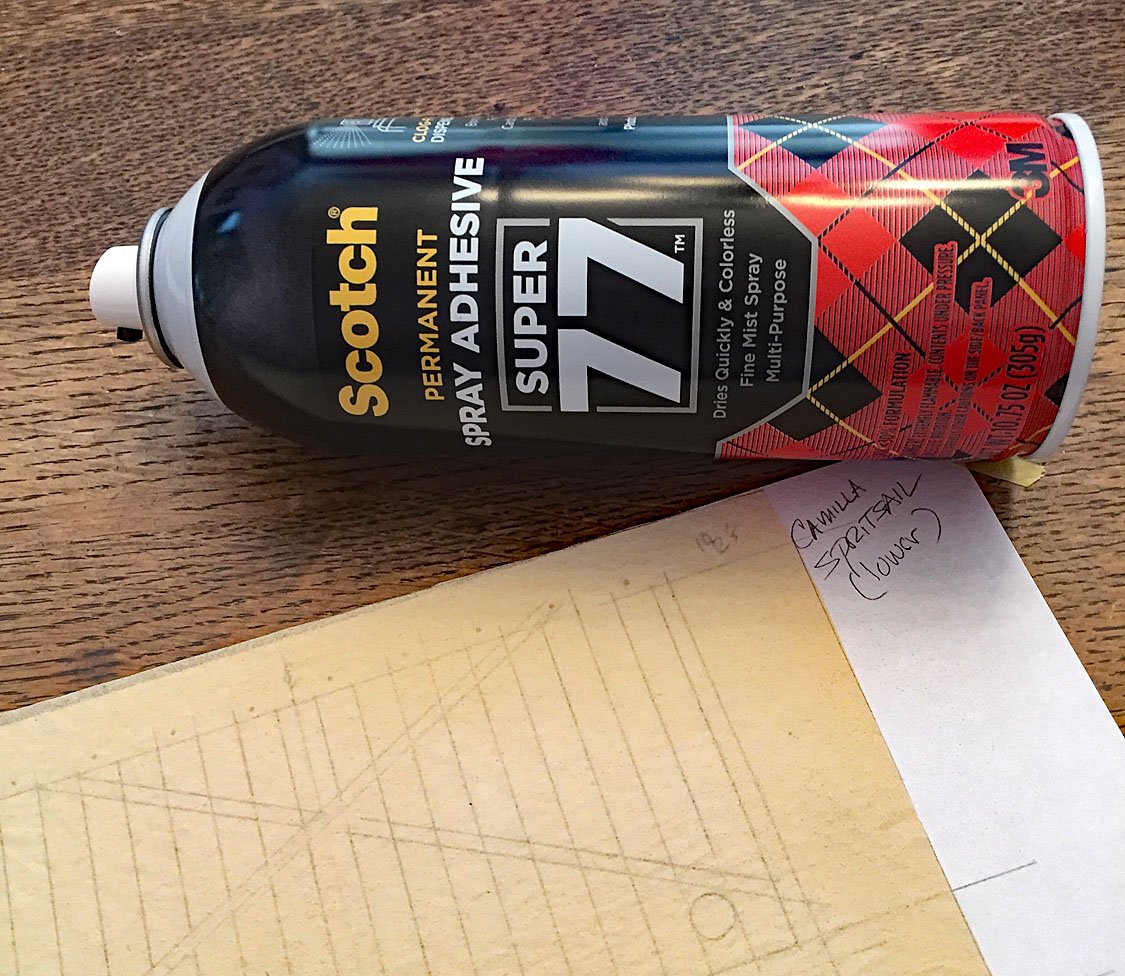
Here's the adhesive I use to attach the silkspan. It is sticky stuff, from the Masters Of The Sticky Universe: 3M. There are different sprays available. This one, #77, or another, #45 General Purpose, work well. This spray has an extremely fine mist. Unlike the Liquitex spray can colors, how 3M accomplishes this without clogging the nozzle is very ZEN. I've tried other adhesives. Trust me, this is the best and most efficient way to get this done.
I show this photo now since the little acrylic bottles were at-hand. You can easily see the difference between the pure white of the bond paper, the colored silkspan (in Unbleached Titanium) and a Devon Clotted Creme-looking Parchment color acrylic (foreground) ..Mmmmmm....that I'll use later on some of the sail linings as well as other areas of the finished sail.
Voilá! Eight (8) silkspan laminated sail layout sheets with nine (9) sails (both upper and lower spritsails are on a single sheet-foreground). One side's lamination is done. These will dry o'night. Prepared pieces of silkspan for the opposite sides are beneath and will be added next (tomorrow?). I've got a number of scrap pieces of painted silkspan for each of the sail's linings and tablings; these need to be precisely cut into their final sizes and glued onto the sails. I'll use a different adhesive for this task since the giant can of immensely sticky 3M spray isn't the right tool for that job.
Yes, Not my workshop.
I'm spraying sticky, icky glue in my garage - not in my basement workshop. Like the smelly toxic paint process, glue spraying is best done outside. My large dining room table is closest to my garage and has a large, smooth, flat surface and - oh yeah! - the Admiral is one of the most understanding ones in our hobby, certainly in this household's admin. I am a lucky sailor. She keeps telling me that. Must be true. This is the evidence...
- Thukydides, bruce d, Hartron and 8 others
-
 11
11
-
20 minutes ago, allanyed said:
The method shown her obviously works very well. There are also great step by step details in the multipart video for making silk span sails by Tom Lauria and in the booklet by David Antscherl available from SeaWatch for $5. There are slight differences but the basics are the same in the last two choices.
Allan
Absolutely, Allan.
I have David's excellent SeaWatch Swan Series Supplement and he goes into great detail for working with silkspan; his is also a good, basic technique, including tips on furling silkspan. I've watched Tom Lauria's YouTube(s) and he approaches the task with similar processes.
- druxey, mtaylor and TomShipModel
-
 3
3
-
-
2 hours ago, bruce d said:
Thanks, I have not used either so must ask: are they the same basic material? It is useful to know that you have used the ModelSpan but the processes described are used on Silkspan, I am wondering if the ModelSpan material would perform in the same way with the same results when the same processes are used.
I like the results and would like to replicate them. 👍to Ron.
Bruce, thanks for the shout-out.
1 hour ago, Blue Ensign said:I was working at 1:150 scale, so at larger scales using a central core between layers of Silk/Model span may be required, I don't know, my only square rigger with sails is the Seventy-four.
Yes, ModelSpan is essentially the same as Silkspan. I've used both with prior models. In the U.S. I purchase it directly from a manufacturer, SIG, in different weights (3). As B.E. has suggested there are sources for ModelSpan in the U.K. I have also purchased ModelSpan here in the U.S. from reseller, Bluejacket Shipcrafters.
Blue Ensign, thanks for your additional information. Indeed, at 1:64 more substance to the sail material is required, hence my solution to use my sail "sandwich" combo of bond paper and silkspan. When I add a couple more finishing "tricks" to their fabrication, the sails can be easily shaped and, most importantly, are more substantial and realistic-looking once they're mounted.
- Blue Ensign, mtaylor, bruce d and 2 others
-
 5
5
-
9 hours ago, allanyed said:
It is so nice to see these instead of cloth sails that never look right unless at 1:24 or larger.
Thanks, Allan. I agree that cloth sails - cleverly fashioned and made from a myriad of different materials - have never made me swoon at a model that has them, especially at smaller scales, like my favorite 1:64. There are excellent examples by other ship builders of paper sails, an approach that yields more realistic portrayals. Thanks for sharing your solution to drawing on silkspan with a shaved nib of a Liquitex marker; clever! I find that the carefully drawn pencil lines on the bond paper suffice, particularly after they've been slightly muted with the application of the layered silkspan "sandwich."
As I'll explain soon, I like that my sail sandwich has some "heft" when complete and ready to mount. The heft is a direct result of the layering (still not thicker than .005/6) and a couple additional tricks I employ to have them appear to billow away from their yards and masts. Using only silkspan - even multi-layered - presents nicely, but these sails typically hang rather limply from their yards; fine for a static model but not so convincing for one presented in a diorama.
I'm really happy my build thread has produced some lively interaction with my colleagues on this subject (and others!). So many beautiful ships to build, so little time!
- chris watton, DonSangria, druxey and 3 others
-
 6
6
-
12 hours ago, druxey said:
Nice looking sail color, Ron.
Trivia: 'Unbleached' titanium white does not exist! Originally a batch of regular titanium white paint (TiO2 ) was accidentally contaminated with a little yellow oxide. Rather than ditch the whole batch, the manufacturer decided to sell it as 'unbleached'. It took off, so it's been marketed ever since. True story.
Thank You, druxey!
Trivia makes the world go round...thanks for the background on titanium oxide ( TiO2 ). I'm pleased the manufacturer punted on the batch, otherwise the closest color to it would be "parchment"- which as I'll show in the next steps I also use on my sails for color contrast and...wait for it...a "weathering" touch. The parchment acrylic I use (available also in spray cans), is from a paint pot. I drybrush it on the sails...more on this later.
- mtaylor, chris watton, bruce d and 1 other
-
 4
4
-
2 hours ago, TBlack said:
Ron,
thanks for the tip on the nozzle cleaner. Most useful. Also, I suspect that real sails weren’t uniform in color either. More realism!
Tom
You're welcome, Tom. The cap cleaner is a life (and pocketbook) saver. I forgot to mention that one can also purchase a package of various Liquitex nozzles that produce different spray patterns. I have a set but thus far I haven't had a need to replace any and the basic nozzle on the colored paint - if kept clean - does a fine job. I've tried to handle this painting task with an airbrush but it produced way too many headaches; it just wasn't very efficient time-wise and when the paint consistency was right for creating a consistent application on the silkspan, the airbrush nozzle would clog. Airbrushes are great for certain modeling tasks, coloring silkspan isn't one of them.
On color uniformity - indeed, I suspect that most sails were pretty "raggedy" as well as dingy-looking, this estimation by judging from paintings of the era. Typical sails also had a patch work of random fixes. A typical Royal Navy warship provisioned many rolls of sailcloth for repairs. If a sailing ship lost it's means of propulsion, the crew were in deep doo-doo.
It should be pretty evident to most forum reader's of my log that I'm creating a diorama that will attempt to portray realism. I've purposefully created my Camilla model with this in-mind. It's a fine line as I've mentioned previously. For example, one can easily overdo the "weathering" of various elements. I try to put the "realism" mostly into sails as well as the portrayal of the sea; a little lower in artistic priority in this regard, is the model itself.
- mtaylor, Ryland Craze, druxey and 2 others
-
 5
5
-
27 minutes ago, EricWilliamMarshall said:
A little work towards the deck fixtures. I stained the wood before sanding the char off. A couple touchups and then CA glue applied with a needle.
That's some crazy small stuff, Eric. Good job getting those stairs to look even. The companionways look good too.
-
14 hours ago, Blue Ensign said:
When my resolve starts to flag with the seemingly endless task of planking these little beggars, I think of James, tasked to complete whatever arrives from the dark Forest of Dean, and to a standard demanded by the Gods. Any failure means the task is repeated, any success and the reward is more of the same.
I then feel much better.😉
🤣🤣🤣 ...James' purgatory will be documented in The Poor James' Almanac.

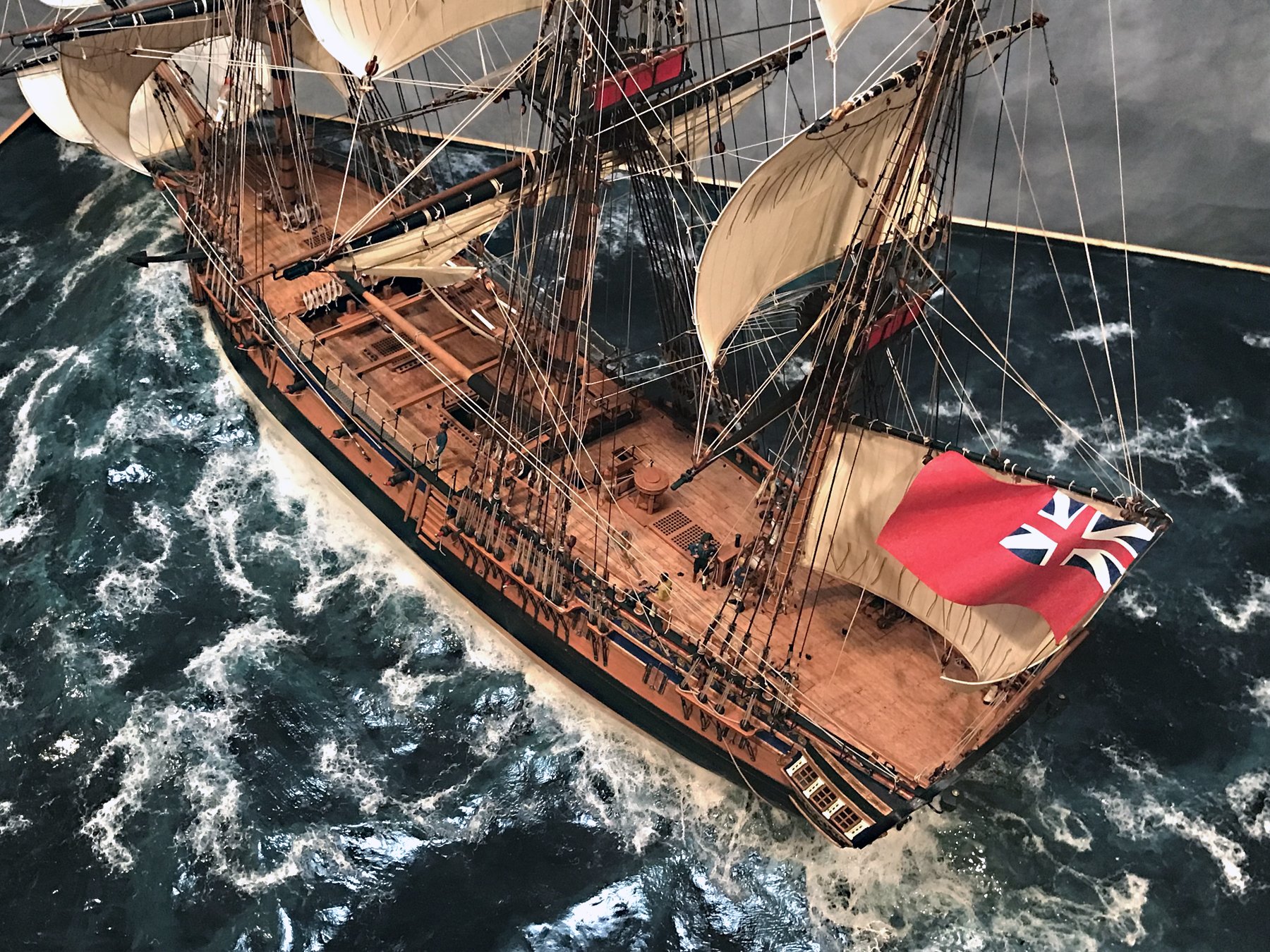
.jpg.d84ec4dad1d7791e855dca06210ab6f3.thumb.jpg.f45209242e851d4409eca1a09293165b.jpg)
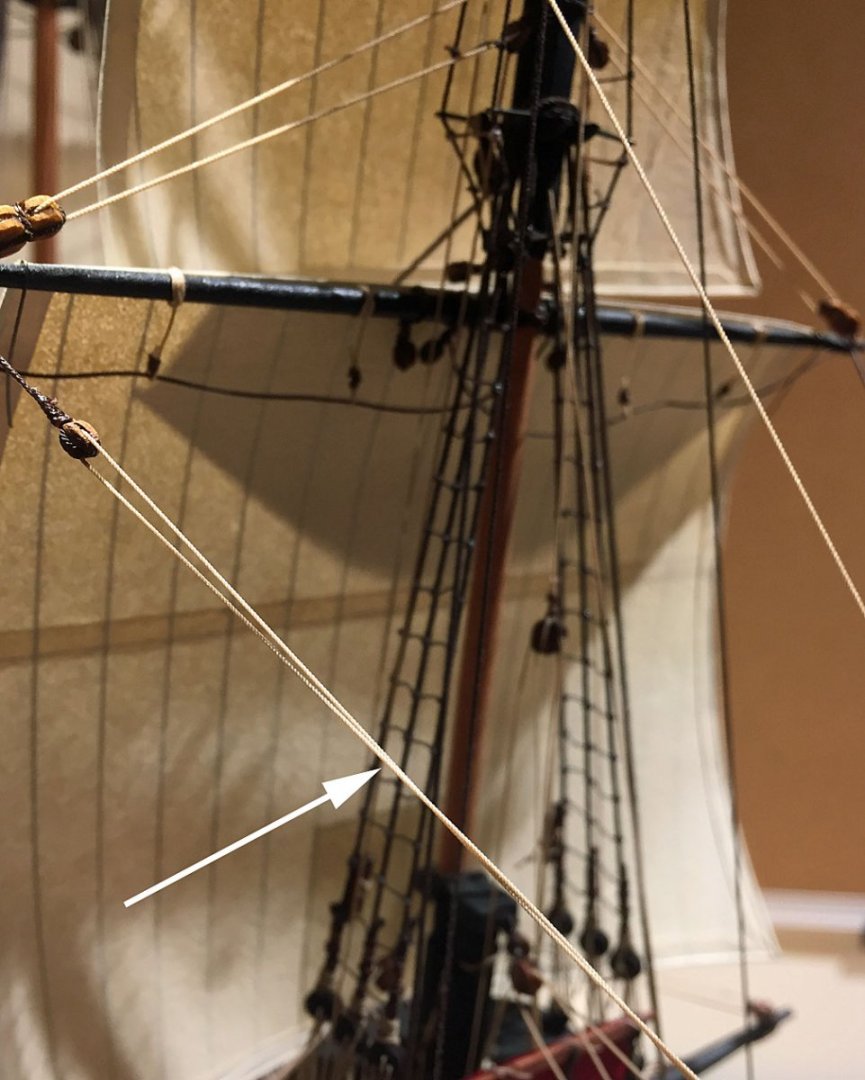
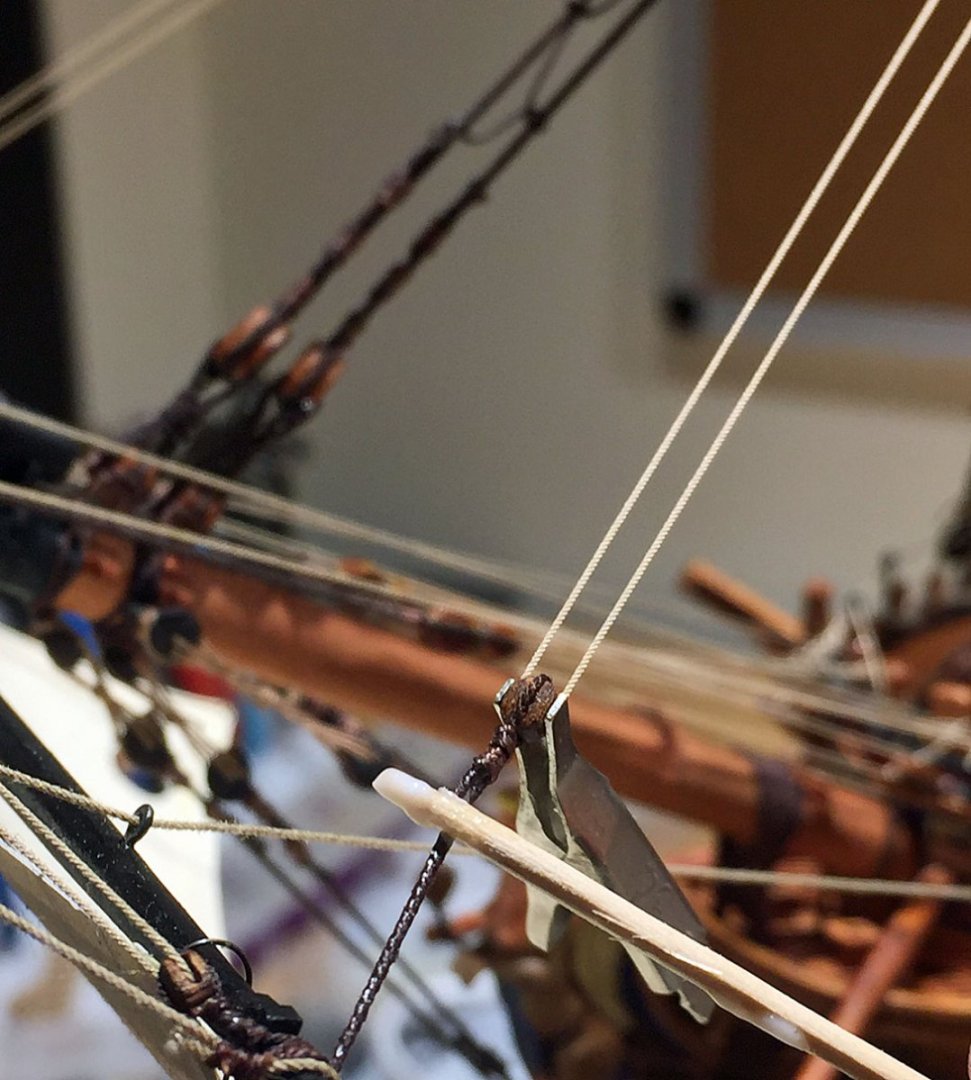
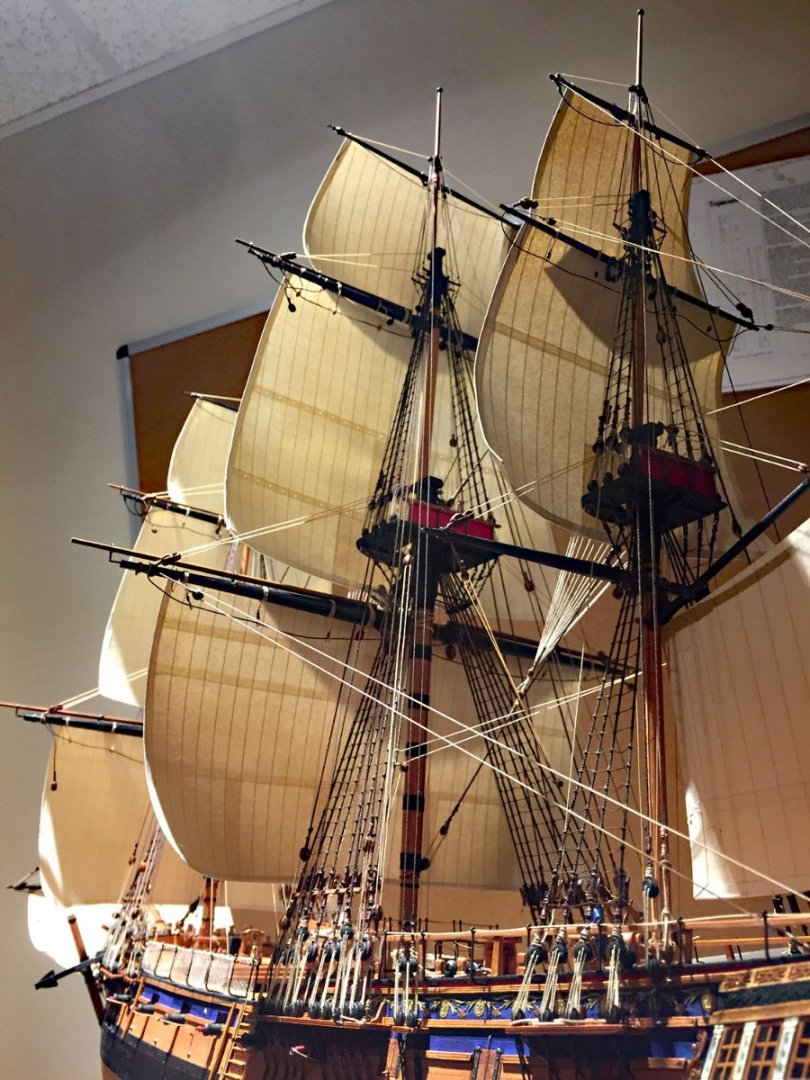
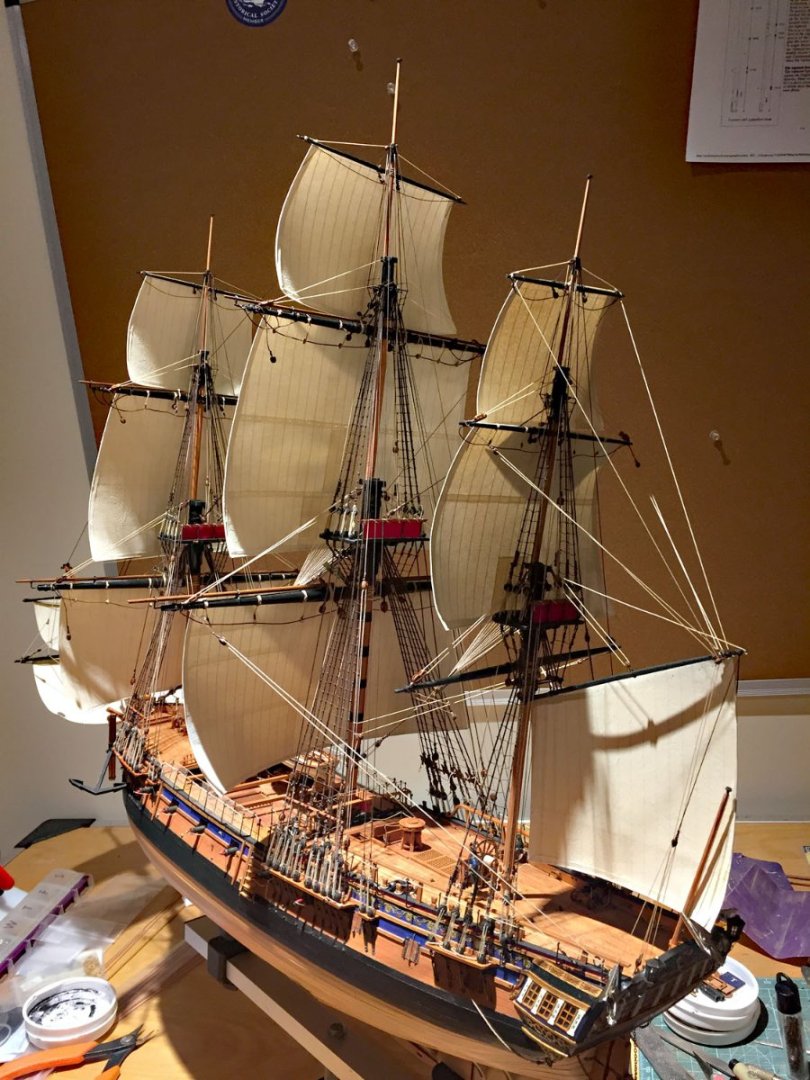
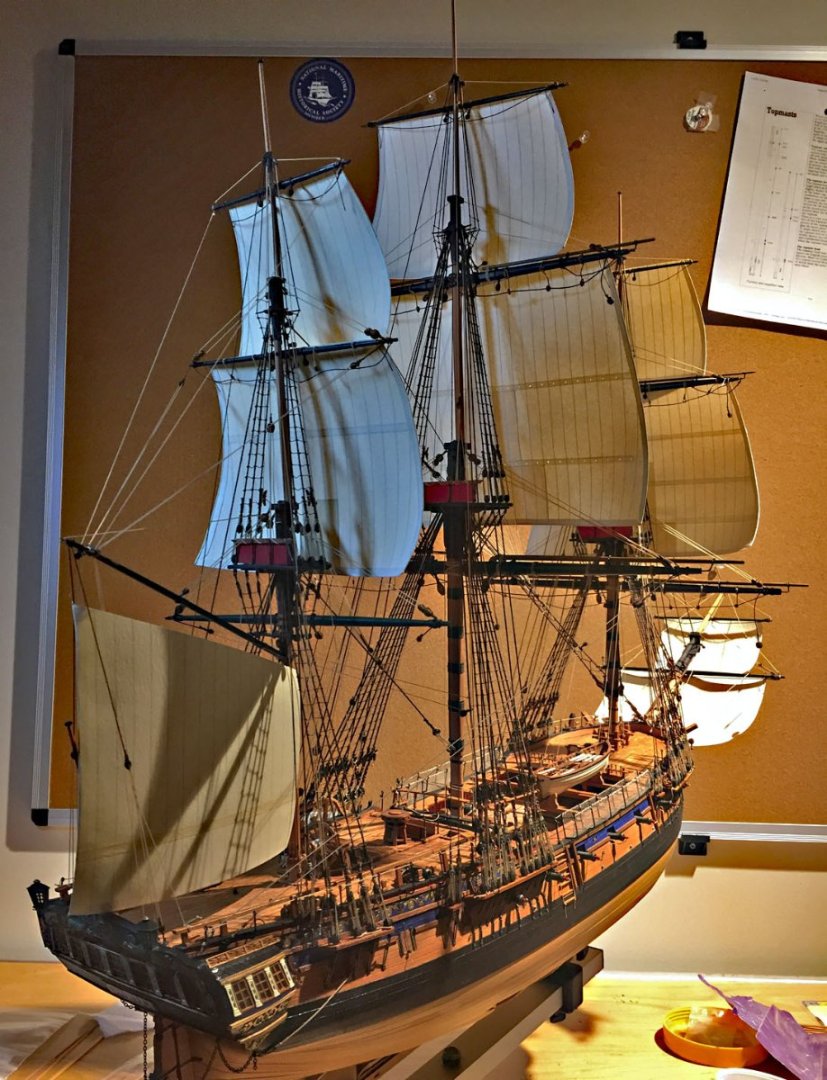
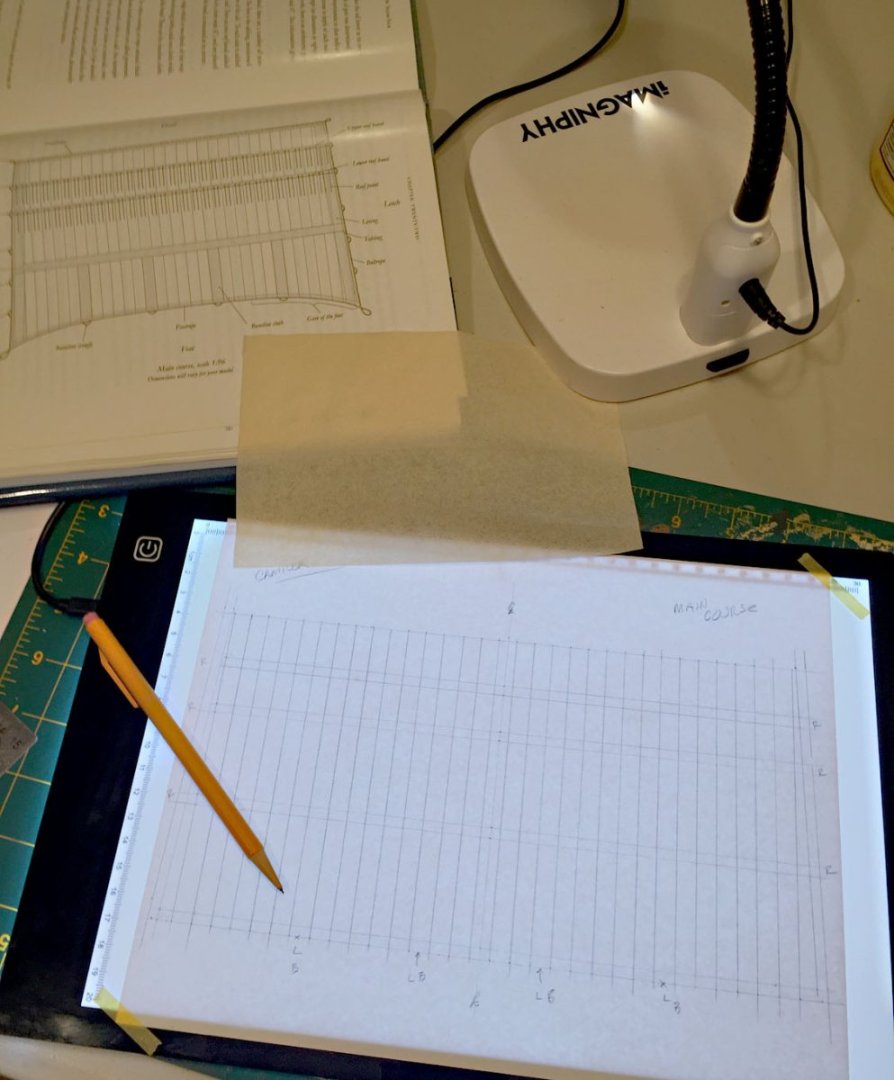

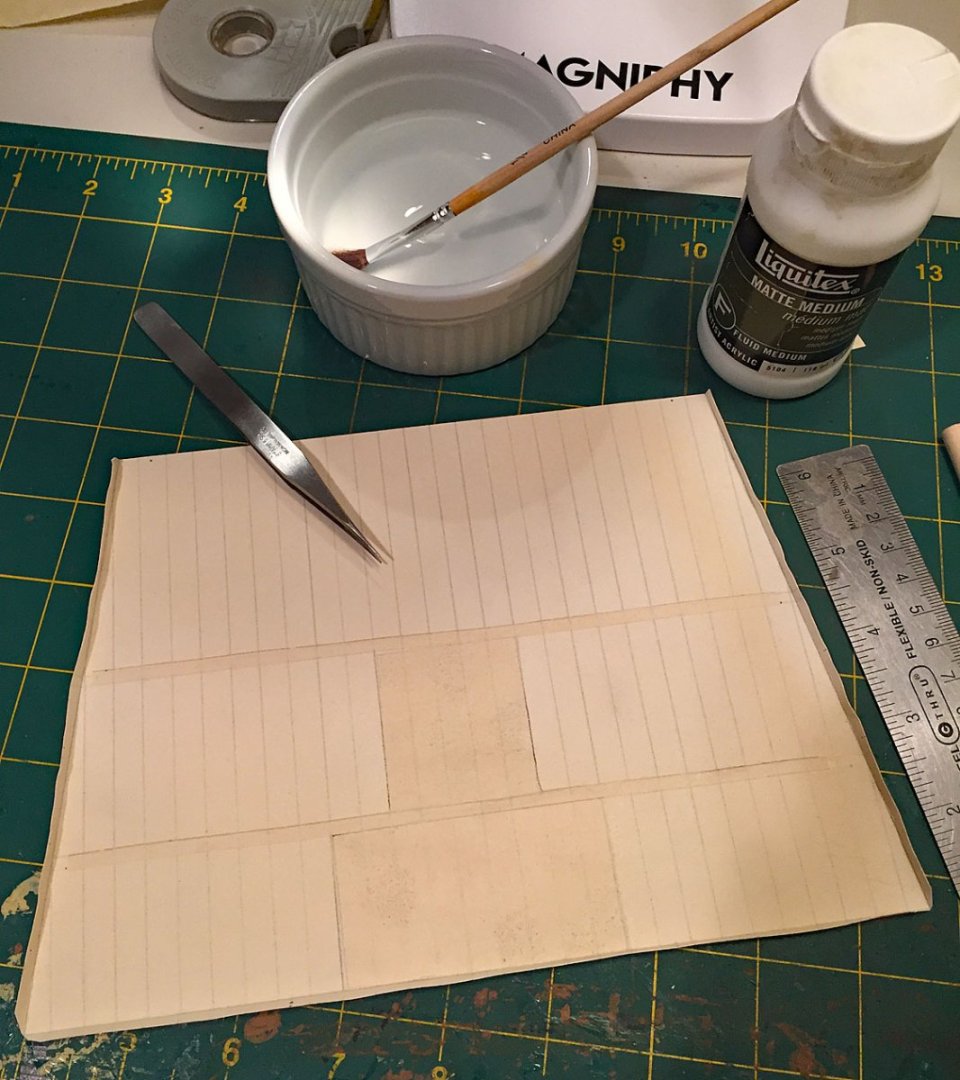
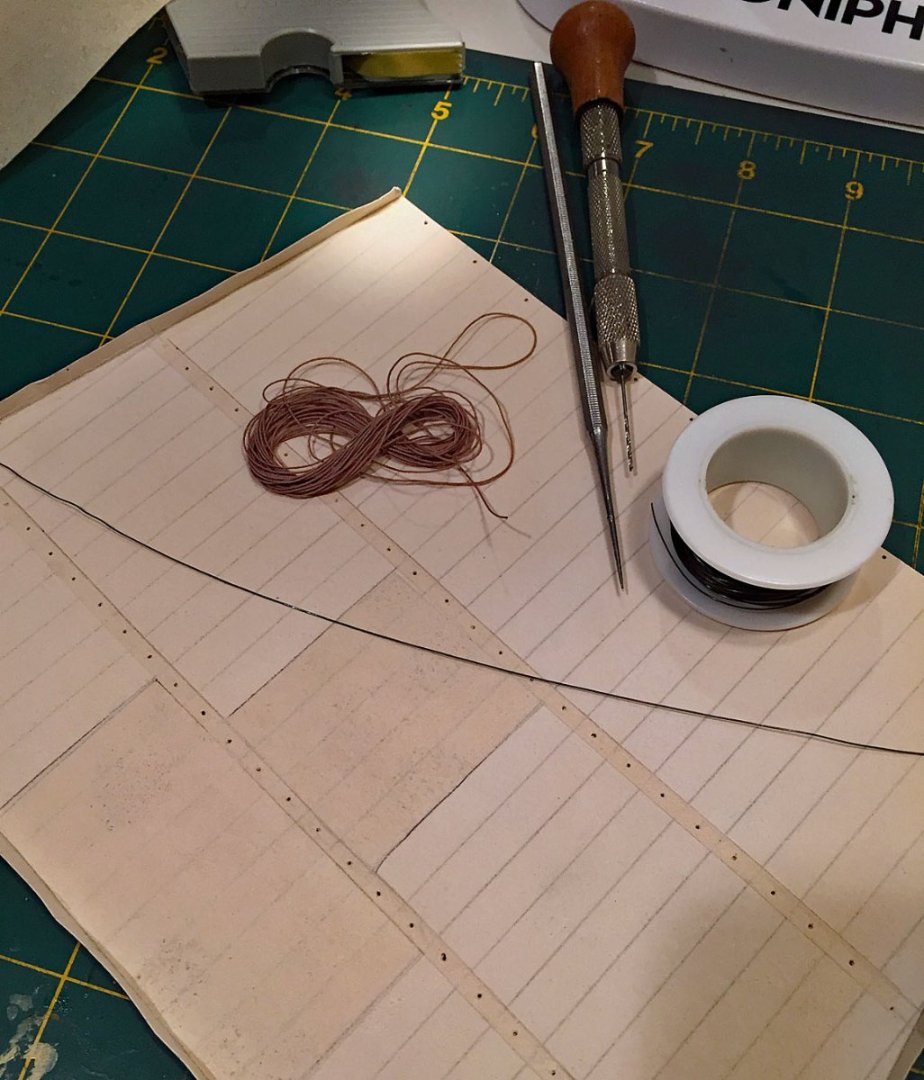
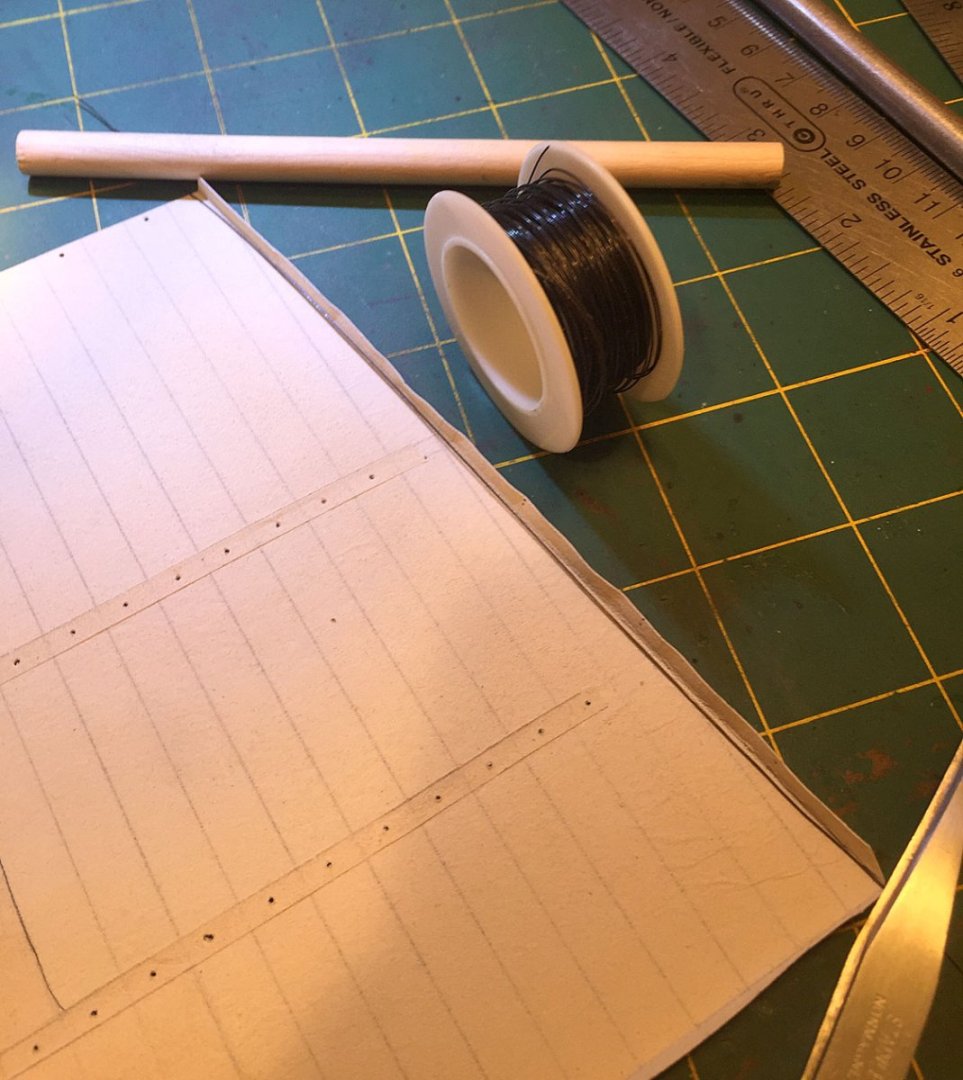
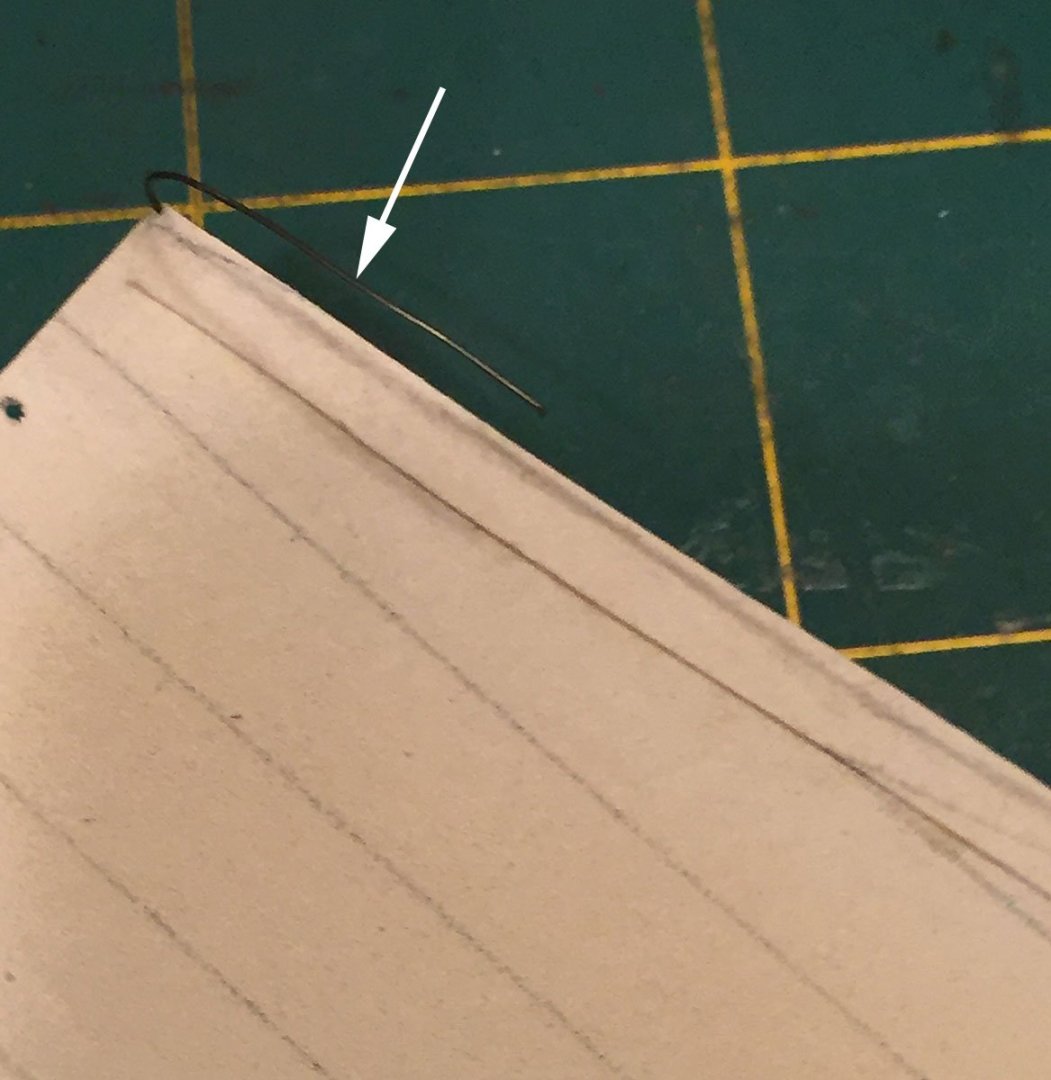
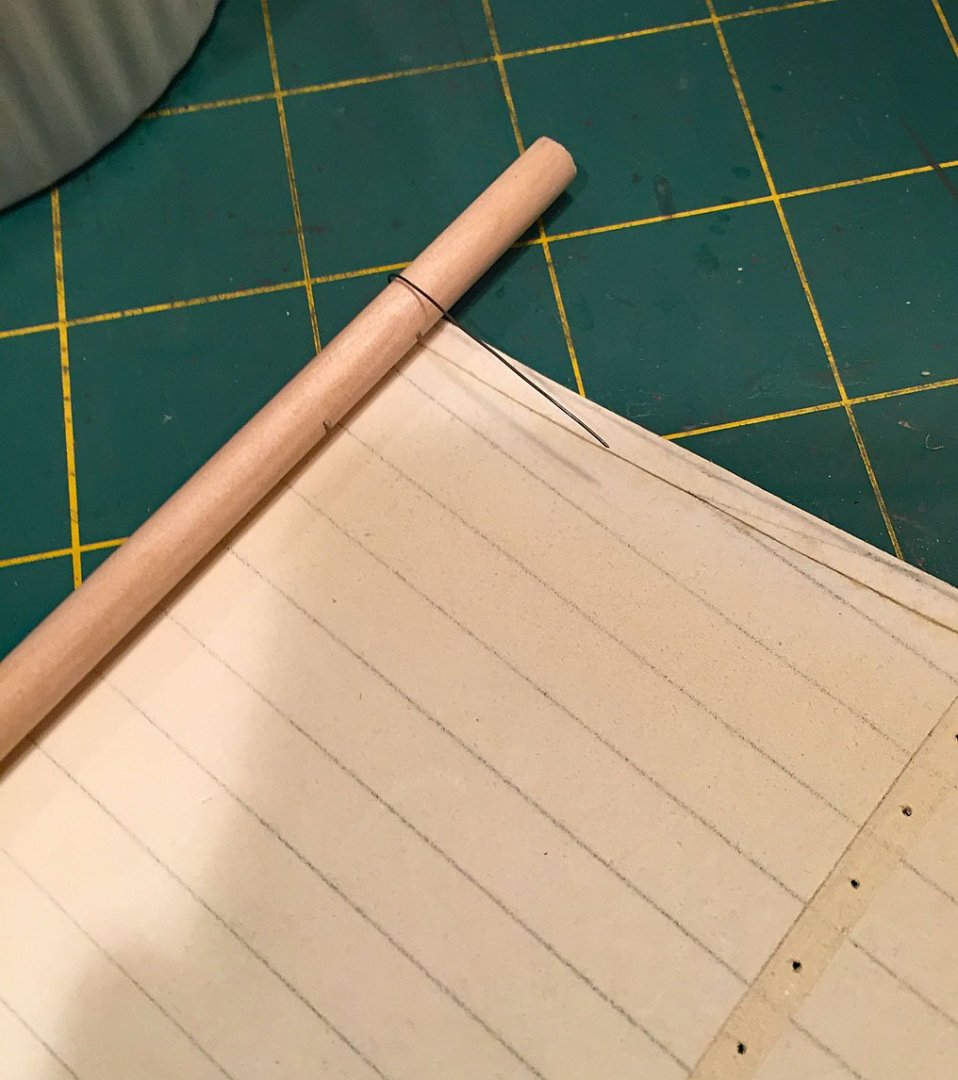
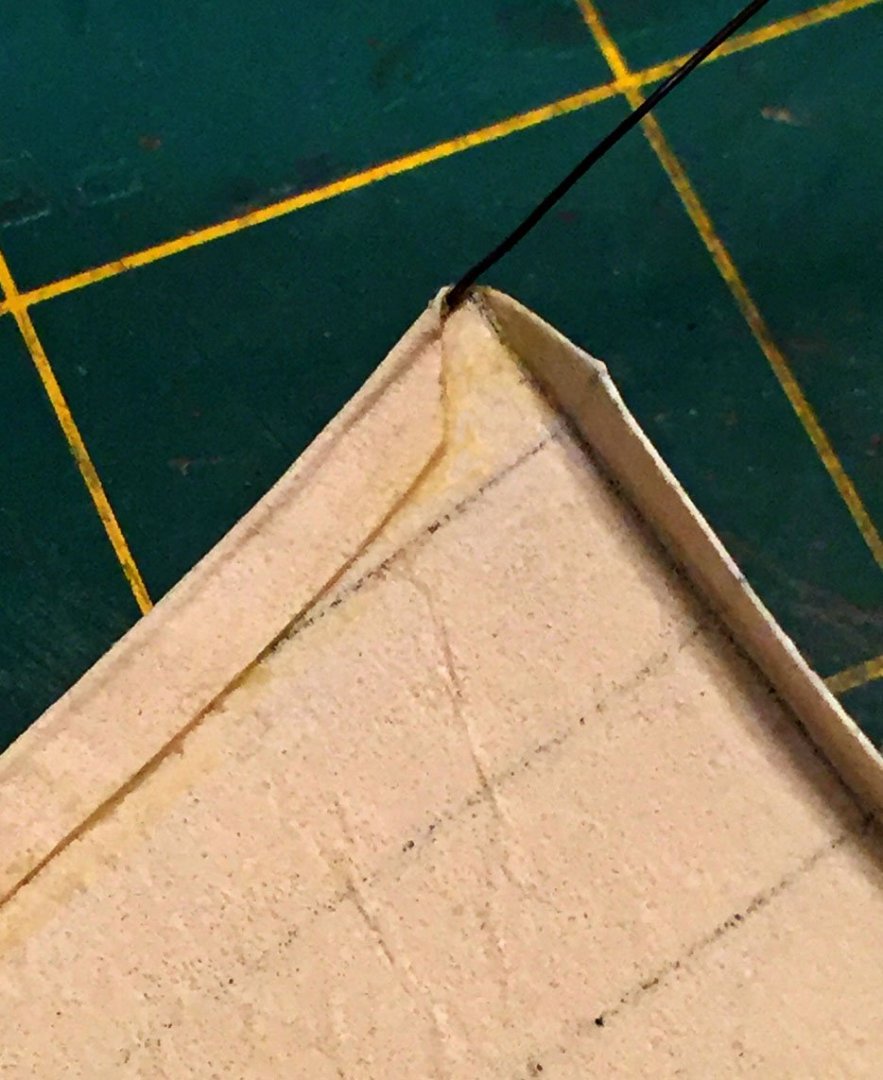
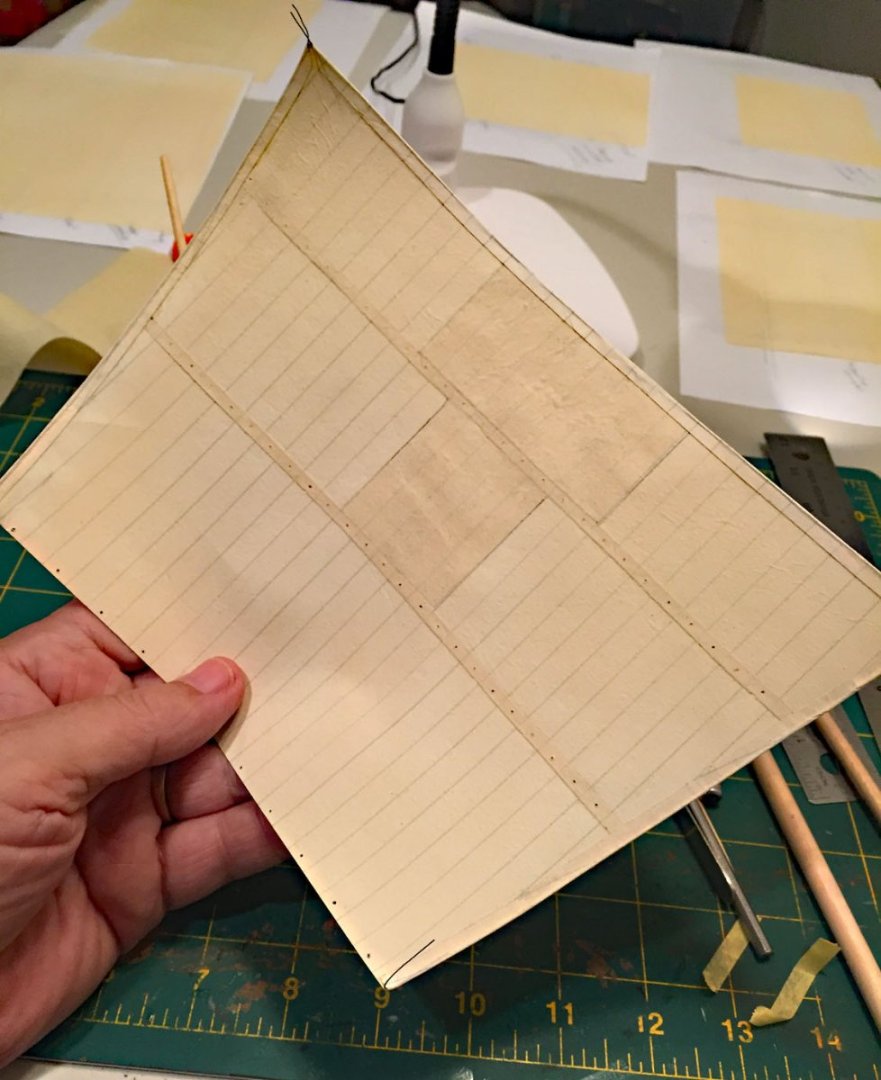
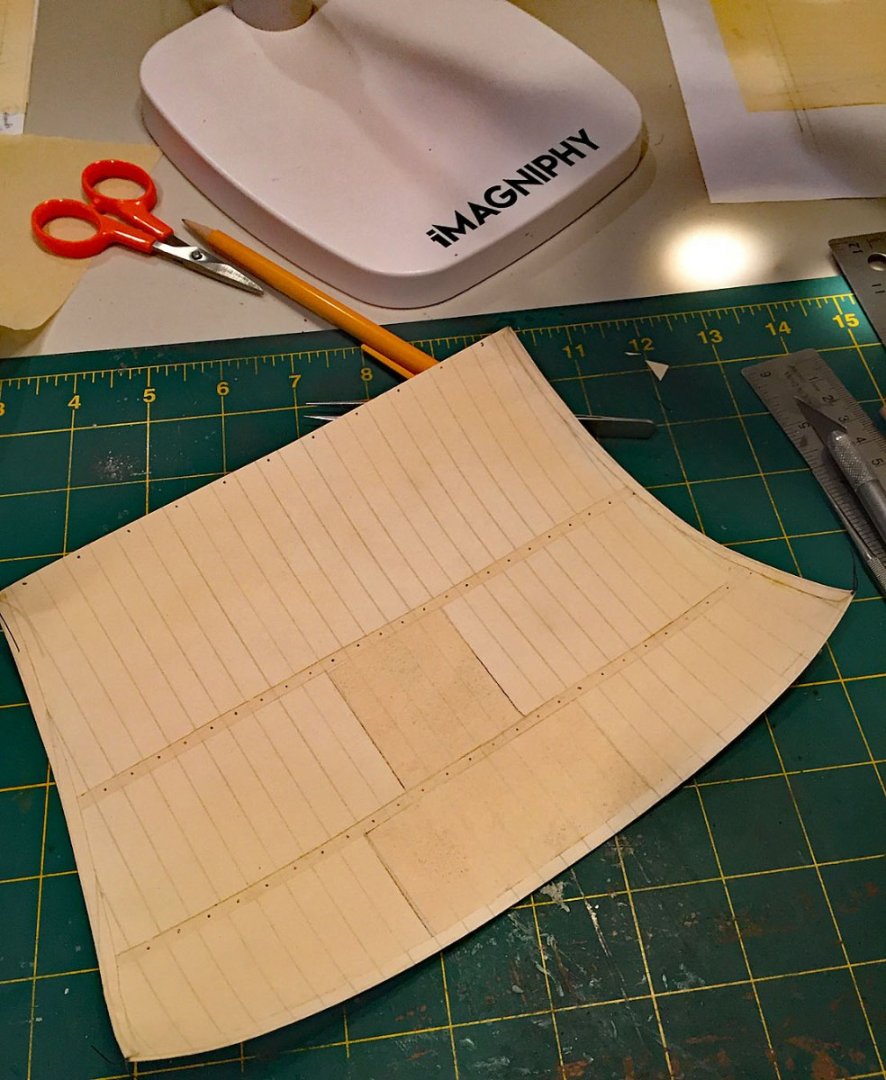
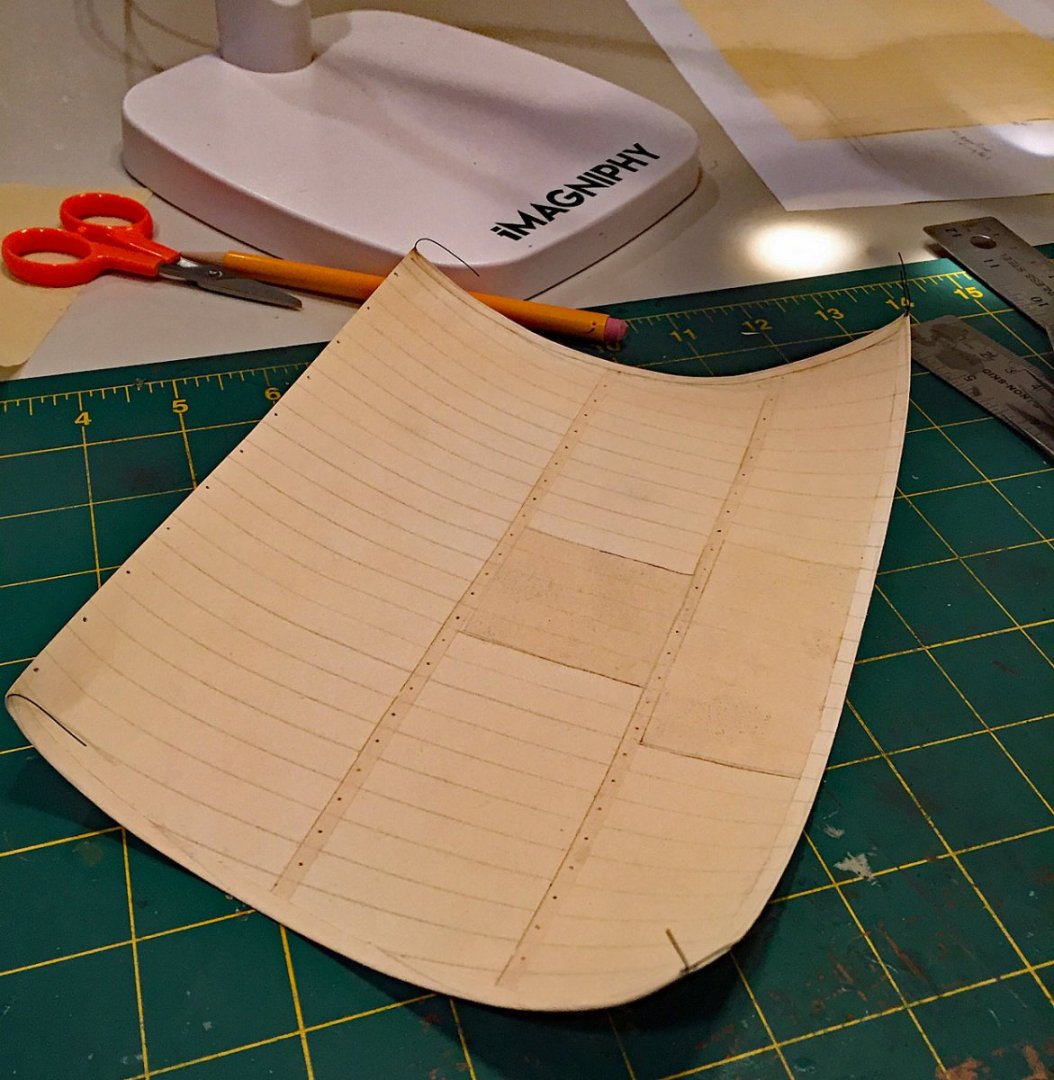
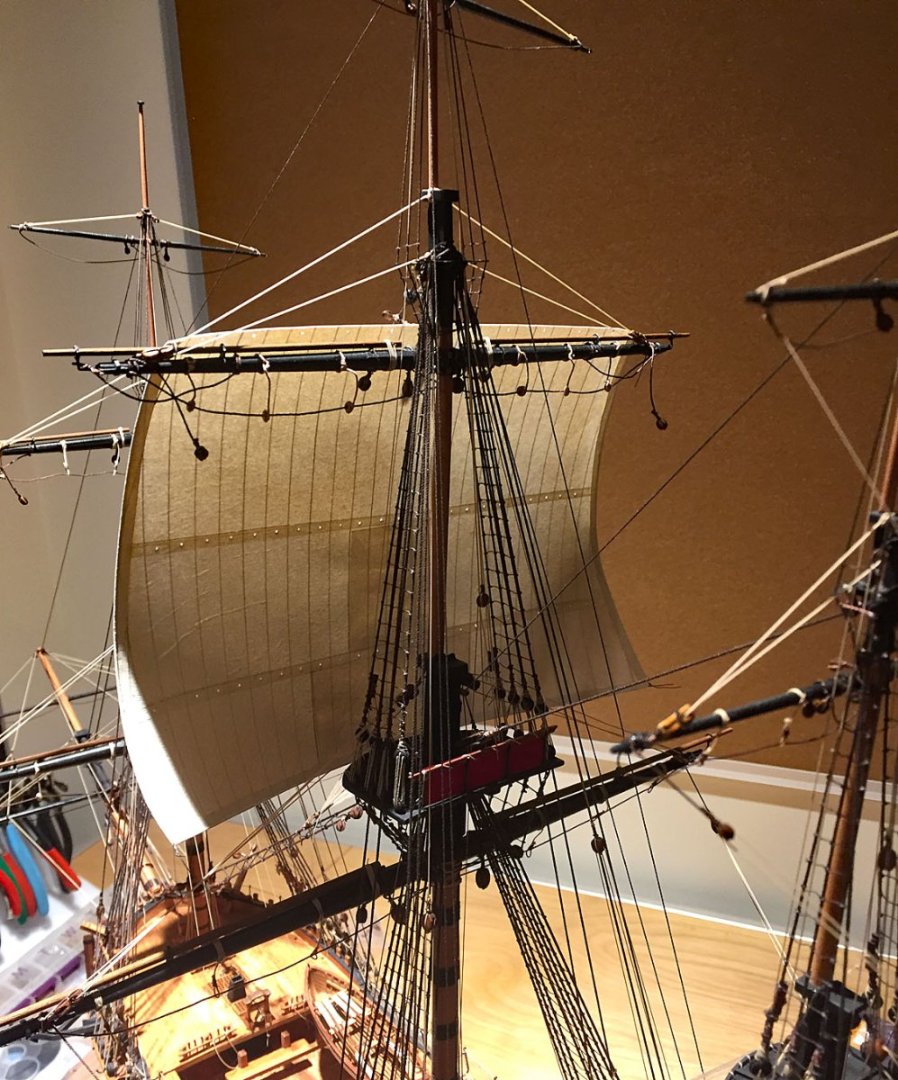
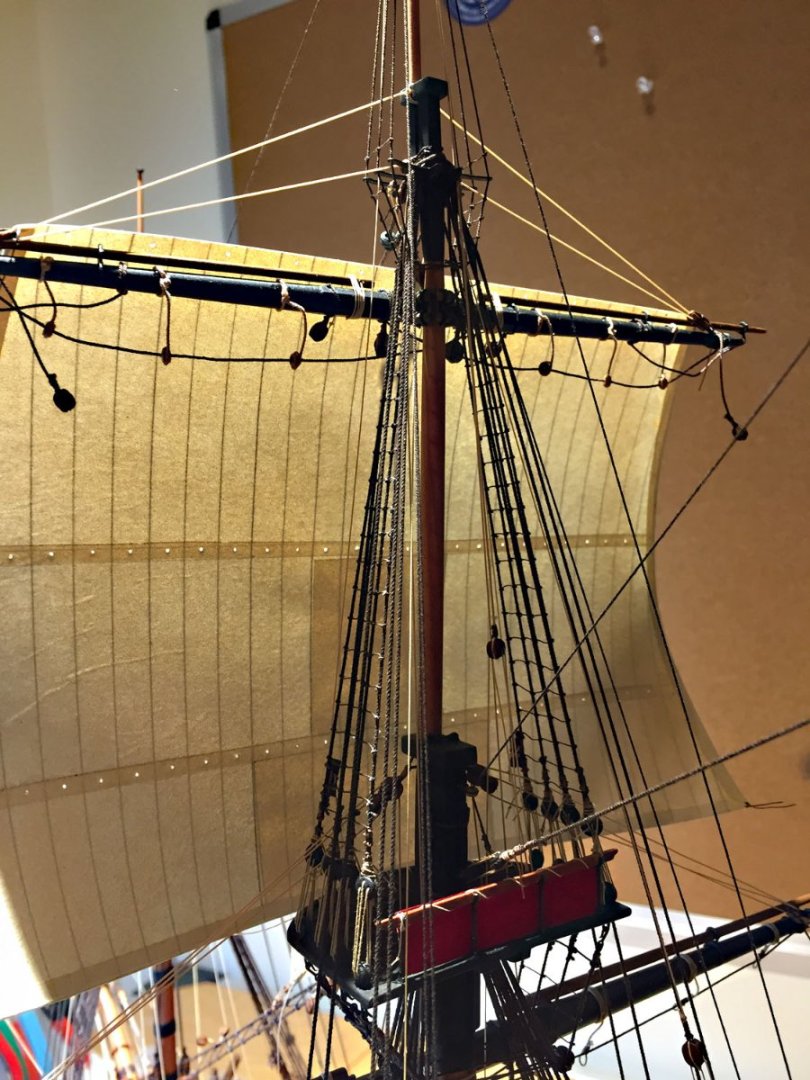
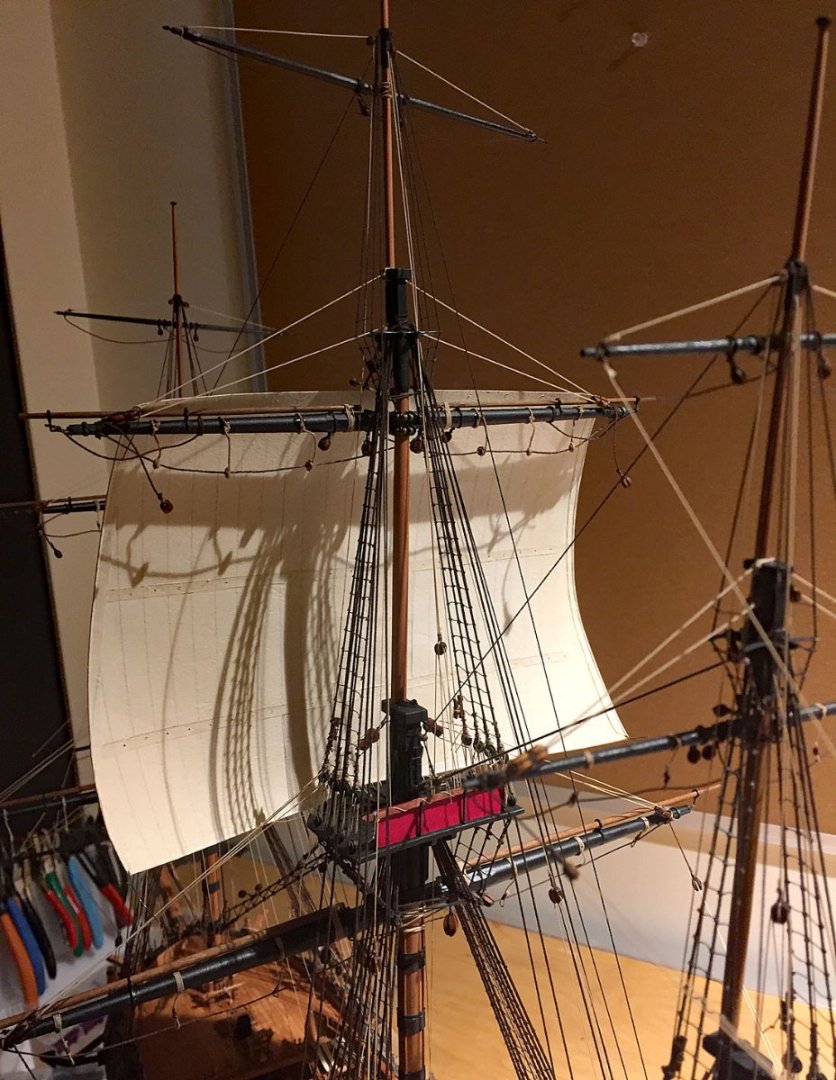
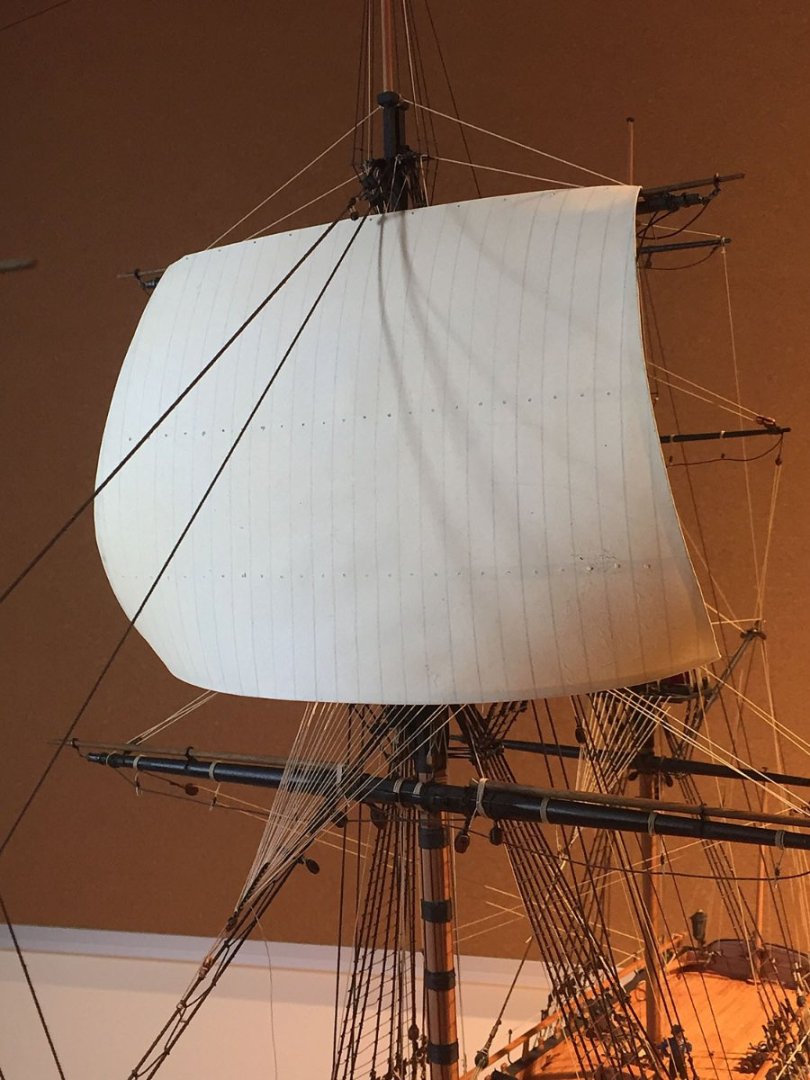
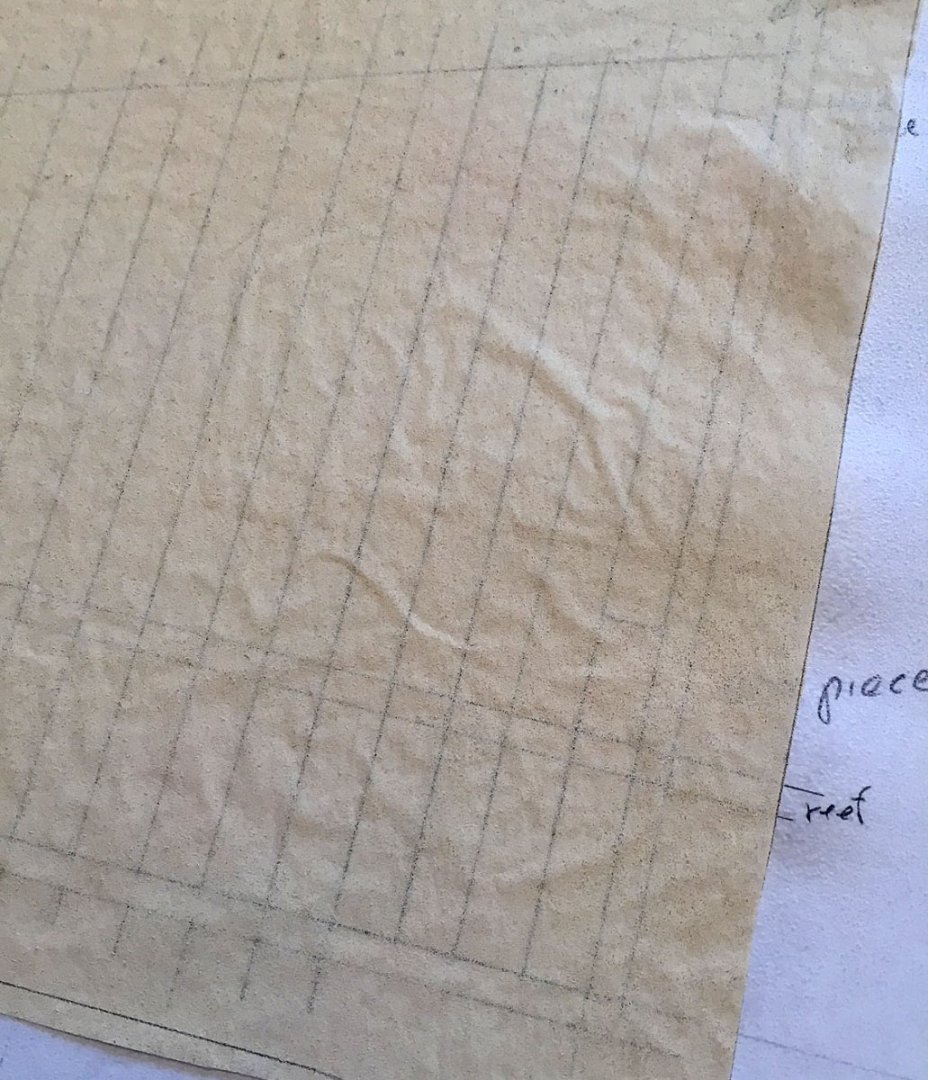

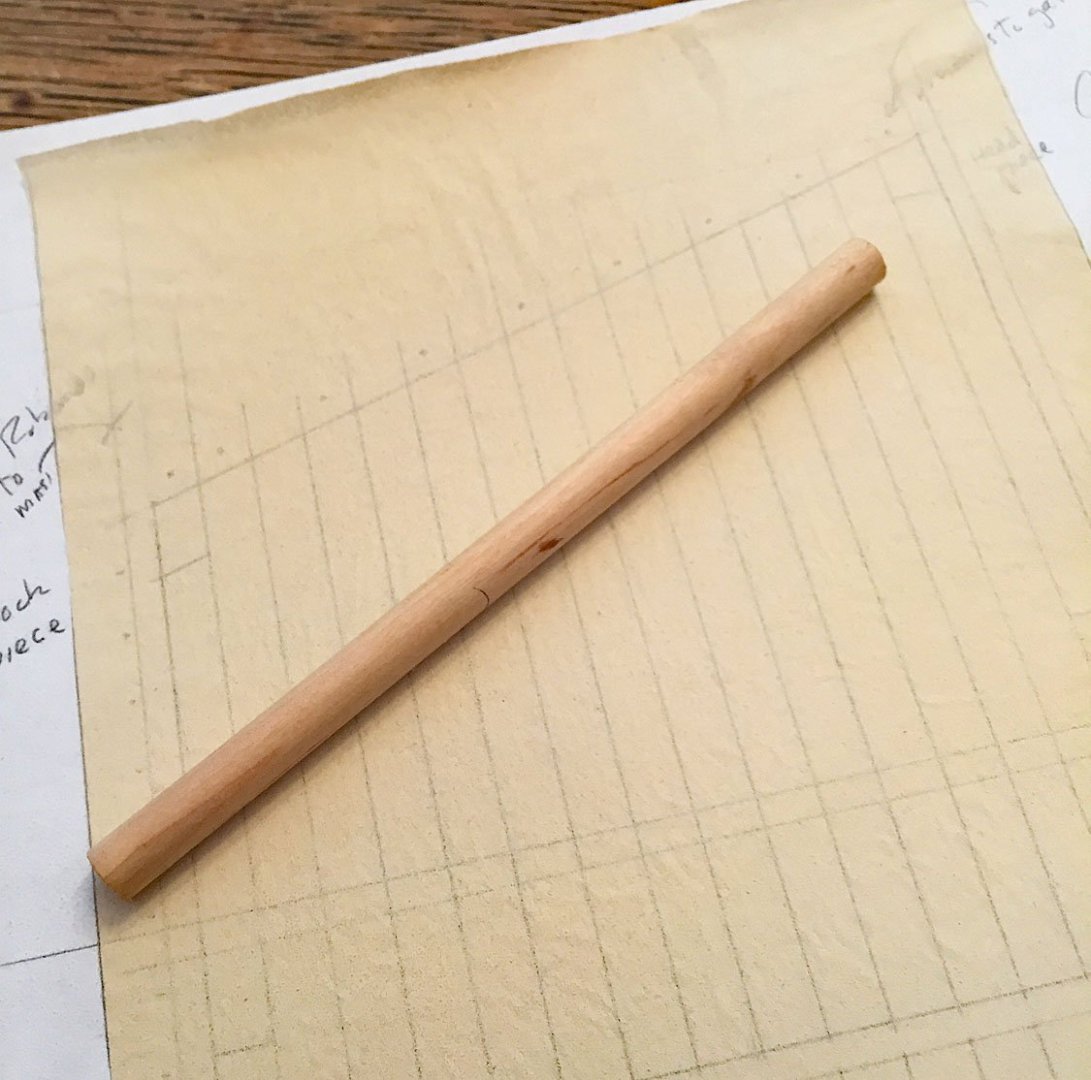
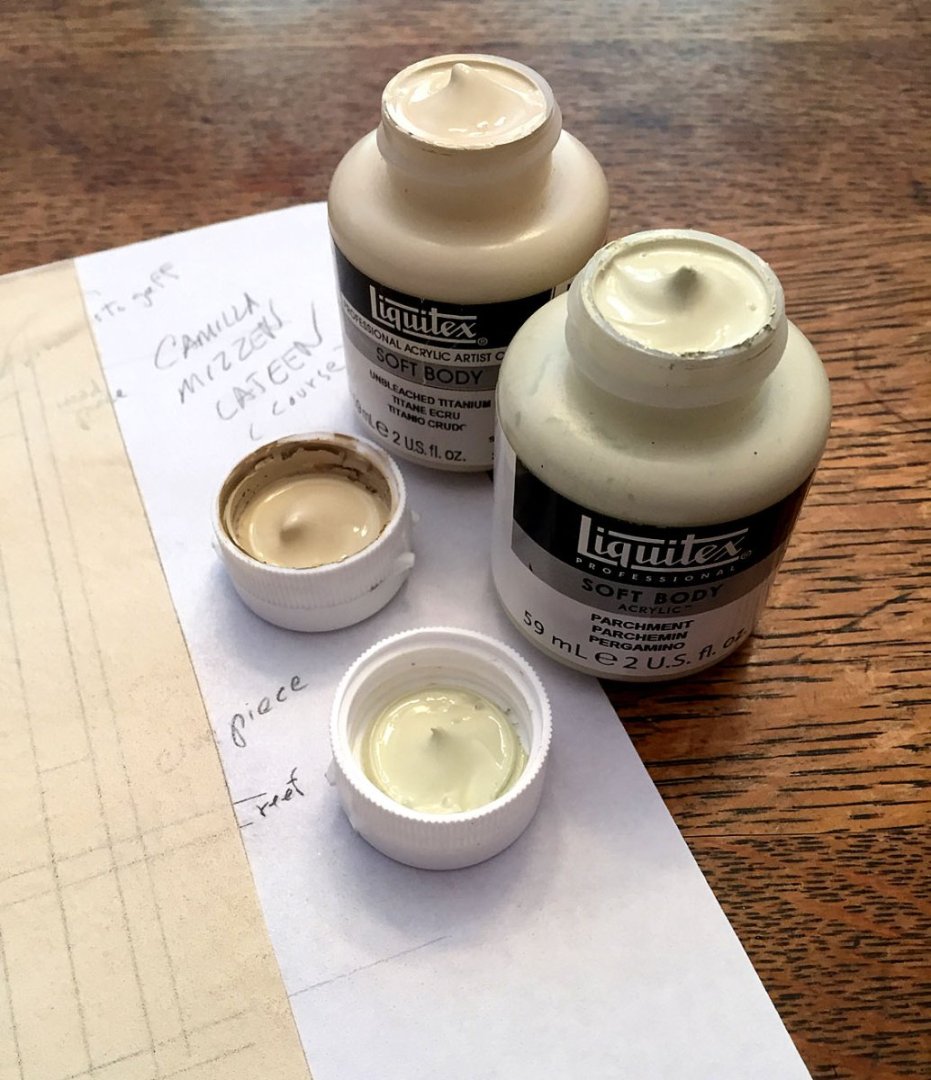


HMS Sphinx 1775 by Hollowneck - FINISHED - Vanguard Models - 1:64
in - Kit build logs for subjects built from 1751 - 1800
Posted
I'll trust the locals on this!
Thanks, Nipper. Yes, the Channel seas can certainly be like the Hunt & Platje paintings with their complex hues of muted blues. I'm leaning toward Camilla's sea looking as close as I can replicate it as depicted by Platje - not only the colors but the waves and swells. I've been drawn somewhat to the greens hue; on reflection, the Hunt & Platje colors will be a better choice.